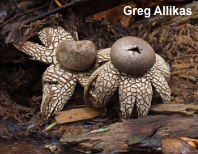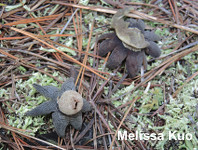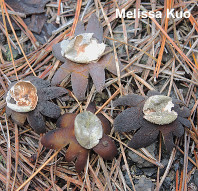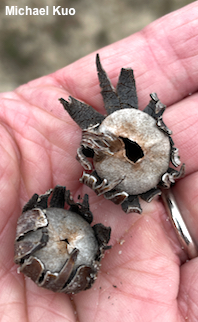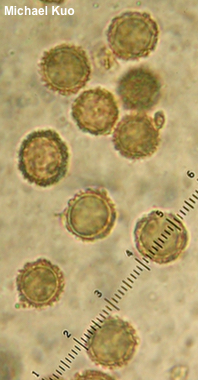| Major Groups > Puffballs > Astraeus hygrometricus |

|
[ Basidiomycota > Boletales > Diplocystidiaceae > Astraeus . . . ] Astraeus hygrometricus by Michael Kuo, 14 February 2024 This little thing is in just about every North American field guide ever published (except mine) and it is collected so frequently that its records take up 18 screens-worth of collections in our nation's major herbaria, databased at MyCoPortal. But I have seen it only twice, in more than 20 years of collecting. Perhaps I keep missing it, or maybe I don't collect very often in sandy, disturbed-ground areas (which is where Astraeus hygrometricus is usually found). Or maybe I'm just flipping incompetent. At any rate, I have only collected it in the New Jersey pine barrens and in northern Michigan on the shores of Lake Superior—and I have studied collections sent to me from North Carolina and Texas. Astraeus hygrometricus looks like "earth stars" in the genus Geastrum, but its rays are "hygroscopic"; they cover the round spore case in dry weather but peel away from it in wet conditions. The inner (or "upper") surfaces of the rays become finely cracked, and the surface of the spore case is matted-fibrillose. The spore powder, at maturity, is chocolate brown—and, under the microscope, the spores are much larger than the spores of Geastrum species. Geastrum and Astraeus are not, in fact, very closely related; Geastrum is related to the stinkhorns, while Astraeus is related to the boletes. Thus the ball-on-a-star strategy for dispersing spores is an example of convergent evolution, not phylogenetic similarity. A study by Phosri and collaborators (2013) suggests support for several phylogenetic species within Astraeus hygrometricus, including North American species the authors named Astraeus morganii and Astraeus smithii—but the paper suffers from terrible (at times incoherent) writing, inconsistent species descriptions, significant errors in geography, poor documentation, inadequate sampling, missing methods, and reliance on a single-gene phylogeny; in short, the new species names, while "legitimate" in a strictly nomenclatural sense, will need to be reconsidered by a more responsible taxonomic inquiry before they can be applied with any degree of accuracy. Contrary to popular assumptions in online venues where collectors are eager to apply the names morganii and smithii, neither range nor spore size is coherently presented in the 2013 Phosri paper. Wisconsin is in the central United States while Michigan is in the northern United States; Southwest Colorado is "close to the Texan border"; spore dimensions are given without indicating whether ornamentation is included; microscopy is performed "as described in Phosri et al. (2004)," but Phosri 2004 says only that "conventional methods were used to study the basidiomes," and that spores were mounted "in Melzer's reagent (Largent et al. 1977)," when what the Largent source actually says is that "[w]ater should routinely be the first liquid in which spores are studied," after which "spores should be studied in several, different liquids," referring researchers to a list of 21 chemical reagents. And so on, and so on, throughout the paper. So, Captain iNat, what I'm saying is, you might want to give it a rest. Thanks to Greg Allikas and Sister Mary Philomena, O. P., for documenting, collecting, and preserving Astraeus hygrometricus for study; their collections are deposited in The Herbarium of Michael Kuo. Description: Ecology: Mycorrhizal; growing alone, scattered, or gregariously in sandy soil, especially in disturbed-ground areas, near hardwoods or conifers; summer and fall (over winter in warmer climates); originally described from Europe; widely distributed in Europe, Asia, Oceania, North America, Central America, and South America. The illustrated and described collections are from Michigan, New Jersey, North Carolina, and Texas. Fruiting Body: A more or less spherical spore case sitting atop pointed rays that fold over the spore case in dry conditions. Spore Case: 1–2.5 cm across; more or less spherical; dry; matted-fibrillose; papery; rupturing at the top with maturity; whitish becoming grayish to brownish. Interior: White and fleshy when young; becoming chocolate brown and powdery. Rays: Numbering 6–12; more or less triangular or elongated-triangular; about 1 mm thick; inner/upper surface dark brown to black, becoming finely cracked overall; outer/lower surface brown, matted-fibrillose, often covered with sand. Odor: Not distinctive. Spore Print: Brown. Microscopic Features: Spores 7.5–12 µm including ornamentation; globose; echinate; spines densely crowded, 0.5–1 µm long and 1 µm wide at the base; brownish golden in KOH. Capillitial threads 2.5–7.5 µm; wide; yellowish to brownish in KOH; roughened; thick-walled. REFERENCES: (Persoon, 1801) Morgan, 1889. (Saccardo, 1891; Coker & Couch, 1928; Smith, 1951; Smith, 1975; Smith, Smith & Weber, 1981; Arora, 1986; States, 1990; Phillips, 1991/2005; Lincoff, 1992; Metzler & Metzler, 1992; Barron, 1999; Roody, 2003; Bates, 2004; Phosri et al., 2004; McNeil, 2006; Miller & Miller, 2006; Buczacki, 2012; Phosri et al., 2013; Desjardin, Wood & Stevens, 2015; Evenson, 2015; Siegel & Schwarz, 2016; Jeppson in Knudsen & Vesterholdt, 2018; Sturgeon, 2018; Læssøe & Petersen, 2019; Kibby, 2020; Cabrera-Rodríguez et al., 2021; McKnight et al., 2021.) Herb. Kuo 10101509, 01152002, 05252201, 10232202. This site contains no information about the edibility or toxicity of mushrooms. |
© MushroomExpert.Com |
|
Cite this page as: Kuo, M. (2024, February). Astraeus hygrometricus. Retrieved from the MushroomExpert.Com Web site: http://www.mushroomexpert.com/astraeus_hygrometricus.html |
